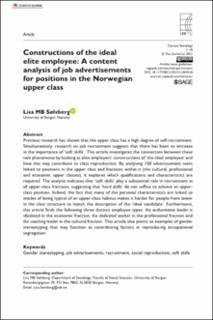| dc.contributor.author | Sølvberg, Lisa Maria Breistein | |
| dc.date.accessioned | 2022-01-27T07:45:16Z | |
| dc.date.available | 2022-01-27T07:45:16Z | |
| dc.date.created | 2021-11-22T12:35:52Z | |
| dc.date.issued | 2021 | |
| dc.identifier.issn | 0011-3921 | |
| dc.identifier.uri | https://hdl.handle.net/11250/2875876 | |
| dc.description.abstract | Previous research has shown that the upper class has a high degree of self-recruitment. Simultaneously, research on job recruitment suggests that there has been an increase in the importance of ‘soft skills’. This article investigates the connection between these two phenomena by looking at elite employers’ constructions of ‘the ideal employee’ and how this may contribute to class reproduction. By analysing 150 advertisement texts linked to positions in the upper class and fractions within it (the cultural, professional and economic upper classes), it explores which qualifications and characteristics are required. The analysis indicates that ‘soft skills’ play a substantial role in recruitment in all upper-class fractions, suggesting that ‘hard skills’ do not suffice to achieve an upper-class position. Indeed, the fact that many of the personal characteristics are linked to modes of being typical of an upper-class habitus makes it harder for people from lower in the class structure to match the description of the ‘ideal candidate’. Furthermore, this article finds the following three distinct employee types: the authoritative leader is idealized in the economic fraction, the dedicated worker in the professional fraction and the coaching leader in the cultural fraction. This article also points to examples of gender stereotyping that may function as contributing factors in reproducing occupational segregation. | en_US |
| dc.language.iso | eng | en_US |
| dc.publisher | SAGE Publications | en_US |
| dc.rights | Navngivelse 4.0 Internasjonal | * |
| dc.rights.uri | http://creativecommons.org/licenses/by/4.0/deed.no | * |
| dc.title | Constructions of the ideal elite employee: A content analysis of job advertisements for positions in the Norwegian upper class | en_US |
| dc.type | Journal article | en_US |
| dc.type | Peer reviewed | en_US |
| dc.description.version | publishedVersion | en_US |
| dc.rights.holder | Copyright The Author(s) 2021 | en_US |
| cristin.ispublished | true | |
| cristin.fulltext | original | |
| cristin.qualitycode | 1 | |
| dc.identifier.doi | 10.1177/00113921211059218 | |
| dc.identifier.cristin | 1957256 | |
| dc.source.journal | Current Sociology | en_US |
| dc.identifier.citation | Current Sociology, 2021. | en_US |

